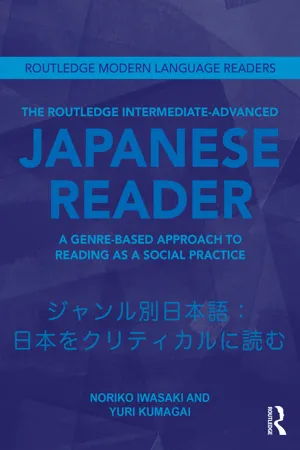
The Routledge Intermediate to Advanced Japanese Reader
A Genre-Based Approach to Reading as a Social Practice
- 268 pages
- English
- ePUB (mobile friendly)
- Available on iOS & Android
The Routledge Intermediate to Advanced Japanese Reader
A Genre-Based Approach to Reading as a Social Practice
About This Book
The Routledge Intermediate to Advanced Japanese Reader: A Genre-Based Approach to Reading as a Social Practice is designed for intermediate to advanced learners of Japanese and presents twenty-five authentic texts taken from a wide range of media and literary sources, which promote a deeper understanding of Japan among readers. The book is divided into ten genre-based chapters, allowing the learner to focus on the textual features relevant to that genre.
Key features include:
- Selected texts covering topics related to Japanese language, society and culture encountered in the Japanese media, from news reports to interviews, book reviews, short stories and editorials.
- Word lists for challenging vocabulary and kanji provided throughout to aid comprehension and learning.
- Pre-reading activities to enable familiarity with the topic, the text's background and words to be encountered in the reading passages.
- Short grammar explanations of essential structures.
- Questions to help comprehension, raise awareness of genre features, promote critical reading, and to encourage the reader to think more deeply about the content.
- Opportunities to write passages, utilizing what has been learned by reading the text.
- Vocabulary and grammar lists at the back of the book.
The Routledge Intermediate to Advanced Japanese Reader emphasizes reading as a purposeful social act, which requires readers to make meaning of the text by considering the authors' choices in language (scripts, vocabulary, styles) in the text. The learners are guided to situate each text in society (for example, the author, target audience, social-cultural background related to the subject) in order to understand the social significance of reading and writing. This book aims to help learners develop the ability to critically read and write in Japanese for their own social purposes. It is suitable for both class use and independent study.
Frequently asked questions
Part I Newspapers: Reporting Texts (Informing)
【ジャンル 1出来事を報告する
Iジャンル2調査結果を報告する
ジャンル 1
出来事を報告する
朝日新聞 | 日経新聞に次ついで高学歴(短大•大学•大学院)の読者が多い。ホヮ イトカラーが50%近くを占しめる。革新かくしん 的なせいとう 政党しじ を支持する人が多い。 |
| 産經新聞さんけい | 男性が56%でやや女性より多い。60歳以上が40%近くを占める。ホワイトカラーが約41%,ブルーカラーが25%。保ほしゅ守的な意いしき 識の人が 多い。 |
日本経済 (日経)にっけい新聞 | 男性が70%近くを占め,40–50歳代が多い。高学歴の人が62 %, ホワイトカラーが67%。与党よとう (ruling party)を支持する人が多いが, 革新的に 傾かたむ いている。 |
毎日新聞 | 60歳以上が40%,無職むしょくが46%を占める。 |
読売新聞よみうり | ホワイトカラーが約35 %。他紙よりブルーカラーの割合が多く , 約26%。保守的な意識の人が多い。 |
(1) 読売新聞 外国人ポランティ ア活躍かつやく
読む前に
Table of contents
- Cover
- Half Title
- Title Page
- Copyright Page
- Table of Contents
- Acknowledgments
- Introduction
- Part I Newspapers: Reporting Texts (Informing)
- Part II Newspapers: Opinion Texts (Appealing; Evaluating)
- Part III Fiction (Entertaining)
- Part IV Spoken Language Texts (Engaging)
- Part V Essays (Narrating; Responding)
- Essential Notes on Genre-based Language Choice
- Wordlist
- Grammar list